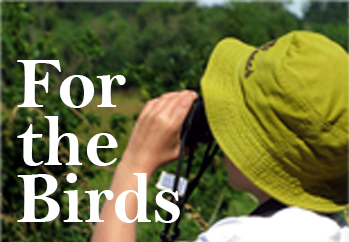Birding Your Patch, and Keeping an Eye Out for Hawks
Opinion Advocates for ideas and draws conclusions based on the author/producer’s interpretation of facts and data.
 By Brian Kluepfel
By Brian Kluepfel
I was not well this weekend. Felled by a one-two punch of a cold and seasonal allergies, I remained relatively housebound for Saturday and Sunday. I elicit no pity or sympathy; sometimes the body needs rest. And I still got out birding on Sunday.
Having a local patch, as a hiker, walker, biker or birder, is helpful. You know how far you are from home – and a bathroom. You know about how far you’ve walked, if you’re a “steps” person. You know where to seek shelter if a sudden squall descends.
As a birder, I know where to find things on my patch. Sometimes it’s the blue jays in the pines that ring the property; there were a handful on Sunday making their usual commotion. Sometimes it’s the chirping red-bellied woodpeckers methodically climbing a trunk while signaling to their mates. I’m confident that on many days a Carolina wren will pop in and out of the thorny scrub along the border with Route 9. Many a cardinal will be in the same location.
An imperious bald eagle is common passing the bench beside the river; today, one glided past, completed a half-circle and headed north, all without flapping its wings. The eagles are so confident that they frequently do not deign to move their wings, allowing the thermals beneath to do all the heavy lifting.
The ring-billed gulls are less fussy and swoop in and out of the tidal waves noisily; ospreys take the middle ground, sometimes soaring, sometimes flapping, sometimes plunging suddenly for a fish. We are often lucky enough to see them succeed and flap off with their catch to a nearby tree limb.
There were some warblers ping-ponging in the treetops today. I am wise enough to admit that I couldn’t identify them positively, so similar are many warblers in appearance. I take that as a birding challenge; one is always learning. Likewise, the flycatcher I saw (briefly) perched in the tall grasses; it may have been one of four species. Pressed for an I.D., I would say eastern wood peewee.
It goes without saying that I would have seen and identified more birds were I accompanied by one of my more expert friends. I sometimes remind myself of a friend from Ethiopia who went to her first-ever baseball game at Yankee Stadium, knowing nothing of the rules.
“What did you do?” I asked.
“We just stood up when everyone else did,” was her logical reply.
The autumn is a wonderful time to stand up on Hook Mountain in Rockland County and count the passing raptors. Each year for more than a half-century, Drew Panko and Trudy Battaly have led this Citizen Science endeavor. On certain days when the winds are right and the temperatures just so, hundreds of hawks, harriers, eagles, ospreys and kestrels float by – some at eye level, and some in “kettles” so high that they appear a dot-matrix pattern on pale blue paper.
Do not fret, however; the experts on the hilltop will help you in the identification. Just climb up from the Rockland Lakes golf course. (You can also do hawk watching at Lenoir Preserve in Yonkers and Chestnut Ridge in Bedford Hills.) Bonus track atop Hook Mountain: gob-smacking views of the Hudson all the way down to Manhattan Island.
So whether it’s your local patch or a trip up Hook Mountain, there’s no time like the present to be present and appreciate the natural wonders of our Hudson Valley. All you have to do is open your eyes and ears.
For information on the Hook Mountain Hawk Watch, visit http://www.battaly.com/hook.
For information on the Chestnut Ridge Hawkwatch in Bedford, visit https://bedfordaudubon.org/chestnut-ridge-hawkwatch.
Brian Kluepfel is an author for the Lonely Planet travel series, as well as Birdwatching and other fine publications, including this one. He encourages you to participate in Saw Mill River Audubon’s activities. For more information about its programs, visit www.sawmillriveraudubon.org.

Examiner Media – Keeping you informed with professionally-reported local news, features, and sports coverage.
